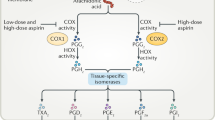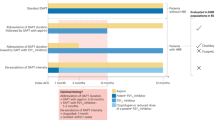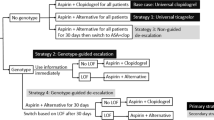Abstract
Cardiovascular disease is both highly prevalent and exceedingly costly to treat. Several novel antiplatelet agents have been found to be effective in reducing the morbidity and mortality associated with cardiovascular disease. Understanding both the economic and the clinical implications of these novel therapies is particularly important. In this article, the results of published evaluations of the cost-effectiveness of oral antiplatelet strategies for use across a range of clinical conditions and treatment settings are reviewed. The results of these studies support the use of aspirin for primary prevention in high-risk patients and for secondary prevention in all patients with previous cardiovascular events. Although the optimal duration of dual antiplatelet therapy after an event remains uncertain, favorable cost-effectiveness estimates have been demonstrated for aspirin plus clopidogrel versus aspirin alone after a myocardial infarction or percutaneous coronary intervention. Moreover, prasugrel has been shown to be more cost-effective than clopidogrel for patients with an acute coronary syndrome and planned percutaneous coronary intervention. As novel antiplatelet agents emerge and existing agents are tested in different patient populations, the evaluation of the relative economic efficiency of these oral antiplatelet treatment strategies will continue to be instrumental to optimally inform clinical and health-policy decision-making.
Key Points
-
The cost-effectiveness of novel compared with standard antiplatelet therapies depends on the balance between risk of ischemic events and bleeding complications, and the impact on clinical effectiveness and costs
-
Low-dose aspirin is economically favorable for primary prevention of cardiovascular disease when the 10-year risk of ischemic events is ≥7.5%, and in all patients after an ischemic cardiovascular event
-
In patients with cerebrovascular disease, either clopidogrel monotherapy or aspirin plus dipyridamole are economically favorable treatment strategies when compared with aspirin alone
-
After a myocardial infarction or percutaneous coronary intervention, aspirin plus clopidogrel is economically favorable compared with aspirin alone
-
Aspirin plus prasugrel is even more economically attractive than aspirin plus clopidogrel in patients with an acute coronary syndrome and planned percutaneous coronary intervention
-
Dual antiplatelet therapy is not cost-effective compared with aspirin alone in the treatment of chronic, stable coronary artery disease, primarily because of the low underlying risk of adverse ischemic events
This is a preview of subscription content, access via your institution
Access options
Subscribe to this journal
Receive 12 print issues and online access
$209.00 per year
only $17.42 per issue
Buy this article
- Purchase on Springer Link
- Instant access to full article PDF
Prices may be subject to local taxes which are calculated during checkout
Similar content being viewed by others
References
Lloyd-Jones, D. et al. Heart disease and stroke statistics—2010 update: a report from the American Heart Association. Circulation 121, e46–e215 (2010).
Riley, R. F., Don, C. W., Powell, W., Maynard, C. & Dean, L. S. Trends in coronary revascularization in the United States from 2001 to 2009: recent declines in percutaneous coronary intervention volumes. Circ. Cardiovasc. Qual. Outcomes 4, 193–197 (2011).
European Heart Network. European cardiovascular disease statistics 2008 [online], (2008).
Laupacis, A., Feeny, D., Detsky, A. S. & Tugwell, P. X. Tentative guidelines for using clinical and economic evaluations revisited. CMAJ 148, 927–929 (1993).
Goldman, L. et al. Cost and health implications of cholesterol lowering. Circulation 85, 1960–1968 (1992).
Sonnenberg, F. A. & Beck, J. R. Markov models in medical decision making: a practical guide. Med. Decis. Making 13, 322–338 (1993).
Mahoney, E. M. & Chu, H. Cost-Effectiveness Analysis Alongside Clinical Trials in Cardiovascular Health Care Economics (ed. Weintraub, W. S.) (Humana Press, New Jersey, 2003).
Critchfield, G. C. & Willard, K. E. Probabilistic analysis of decision trees using Monte Carlo simulation. Med. Decis. Making 6, 85–92 (1986).
Efron, B. Introduction to the Bootstrap (Chapman & Hall, New York, 1993).
Hunink, M. G., Bult, J. R., de Vries, J. & Weinstein, M. C. Uncertainty in decision models analyzing cost-effectiveness: the joint distribution of incremental costs and effectiveness evaluated with a nonparametric bootstrap method. Med. Decis. Making 18, 337–346 (1998).
Fenwick, E., Claxton, K. & Sculpher, M. Representing uncertainty: the role of cost-effectiveness acceptability curves. Health Econ. 10, 779–787 (2001).
Cohen, D. J. & Reynolds, M. R. Interpreting the results of cost-effectiveness studies. J. Am. Coll. Cardiol. 52, 2119–2126 (2008).
Mark, D. B. & Hlatky, M. A. Medical economics and the assessment of value in cardiovascular medicine: Part I. Circulation 10 6, 516–520 (2002).
Mark, D. B. & Hlatky, M. A. Medical economics and the assessment of value in cardiovascular medicine: Part II. Circulation 106, 626–630 (2002).
[No authors listed] Summaries for patients. Aspirin for the prevention of cardiovascular disease: U. S. Preventive Services Task Force recommendation statement. Ann. Intern. Med. 150, 1–37 (2009).
Pearson, T. A. et al. AHA guidelines for primary prevention of cardiovascular disease and stroke: 2002 update: Consensus panel guide to comprehensive risk reduction for adult patients without coronary or other atherosclerotic vascular diseases. American Heart Association Science Advisory and Coordinating Committee. Circulation 106, 388–391 (2002).
Berger, J. S. et al. Aspirin for the primary prevention of cardiovascular events in women and men: a sex-specific meta-analysis of randomized controlled trials. JAMA 29 5, 306–313 (2006).
Lamotte, M., Annemans, L., Evers, T. & Kubin, M. A multi-country economic evaluation of low-dose aspirin in the primary prevention of cardiovascular disease. Pharmacoeconomics 24, 155–169 (2006).
Pignone, M., Earnshaw, S., Tice, J. A. & Pletcher, M. J. Aspirin, statins, or both drugs for the primary prevention of coronary heart disease events in men: a cost-utility analysis. Ann. Intern. Med. 144, 326–336 (2006).
Pignone, M., Earnshaw, S., Pletcher, M. J. & Tice, J. A. Aspirin for the primary prevention of cardiovascular disease in women: a cost-utility analysis. Arch. Intern. Med. 167, 290–295 (2007).
Bhatt, D. L. et al. Clopidogrel and aspirin versus aspirin alone for the prevention of atherothrombotic events. N. Engl. J. Med. 354, 1706–1717 (2006).
Yusuf, S. et al. Effects of clopidogrel in addition to aspirin in patients with acute coronary syndromes without ST-segment elevation. N. Engl. J. Med. 345, 494–502 (2001).
Mehta, S. R. et al. Effects of pretreatment with clopidogrel and aspirin followed by long-term therapy in patients undergoing percutaneous coronary intervention: the PCI-CURE study. Lancet 358, 527–533 (2001).
Weintraub, W. S. et al. Long-term cost-effectiveness of clopidogrel given for up to one year in patients with acute coronary syndromes without ST-segment elevation. J. Am. Coll. Cardiol. 45, 838–845 (2005).
Lamy, A. et al. The cost-effectiveness of the use of clopidogrel in acute coronary syndromes in five countries based upon the CURE study. Eur. J. Cardiovasc. Prev. Rehabil. 11, 460–465 (2004).
Mahoney, E. M. et al. Long-term cost-effectiveness of early and sustained clopidogrel therapy for up to 1 year in patients undergoing percutaneous coronary intervention after presenting with acute coronary syndromes without ST-segment elevation. Am. Heart J. 151, 219–227 (2006).
Lindgren, P., Jönsson, B. & Yusuf, S. Cost-effectiveness of clopidogrel in acute coronary syndromes in Sweden: a long-term model based on the CURE trial. J. Intern. Med. 255, 562–570 (2004).
Lindgren, P., Stenestrand, U., Malmberg, K. & Jönsson, B. The long-term cost-effectiveness of clopidogrel plus aspirin in patients undergoing percutaneous coronary intervention in Sweden. Clin. Ther. 27, 100–110 (2005).
Schleinitz, M. D. & Heidenreich, P. A. A cost-effectiveness analysis of combination antiplatelet therapy for high-risk acute coronary syndromes: clopidogrel plus aspirin versus aspirin alone. Ann. Intern. Med. 142, 251–259 (2005).
Latour-Pérez, J., Navarro-Ruiz, A., Ridao-López, M. & Cervera-Montes, M. Using clopidogrel in non-ST-segment elevation acute coronary syndrome patients: a cost-utility analysis in Spain. Value Health 7, 52–60 (2004).
Sabatine, M. S. et al. Addition of clopidogrel to aspirin and fibrinolytic therapy for myocardial infarction with ST-segment elevation. N. Engl. J. Med. 352, 1179–1189 (2005).
Gibler, K. B. et al. Cost-effectiveness analysis of short-term clopidogrel therapy for ST elevation myocardial infarction. Crit. Pathw. Cardiol. 9, 14–18 (2010).
Chen, Z. M. et al. Addition of clopidogrel to aspirin in 45,852 patients with acute myocardial infarction: randomised placebo-controlled trial. Lancet 366, 1607–1621 (2005).
Zhang, Z. et al. Long-term cost-effectiveness of clopidogrel in STEMI patients. Int. J. Cardiol. 135, 353–360 (2009).
Wiviott, S. D. et al. Prasugrel versus clopidogrel in patients with acute coronary syndromes. N. Engl. J. Med. 3 57, 2001–2015 (2007).
Mahoney, E. M. et al. Cost-effectiveness of prasugrel versus clopidogrel in patients with acute coronary syndromes and planned percutaneous coronary intervention: results from the trial to assess improvement in therapeutic outcomes by optimizing platelet inhibition with Prasugrel-Thrombolysis in Myocardial Infarction TRITON-TIMI 38. Circulation 121, 71–79 (2010).
US Food and Drug Administration. Effient (prasugrel): Full Prescribing Information [online], (2010).
Chin, C. T. et al. Study design and rationale of a comparison of prasugrel and clopidogrel in medically managed patients with unstable angina/non-ST-segment elevation myocardial infarction: the TaRgeted platelet Inhibition to cLarify the Optimal strateGy to medicallY manage Acute Coronary Syndromes (TRILOGY ACS) trial. Am. Heart J. 160, 16–22e1 (2010).
Cannon, C. P. et al. Comparison of ticagrelor with clopidogrel in patients with a planned invasive strategy for acute coronary syndromes (PLATO): a randomised double-blind study. Lancet 375, 283–293 (2010).
Crespin, D. J., Federspiel, J. J., Biddle, A. K., Jonas, D. E. & Rossi, J. S. Ticagrelor versus genotype-driven antiplatelet therapy for secondary prevention after acute coronary syndrome: A cost-effectiveness analysis. Value Health 14, 483–491 (2011).
Mauri, L. et al. Rationale and design of the dual antiplatelet therapy study, a prospective, multicenter, randomized, double-blind trial to assess the effectiveness and safety of 12 versus 30 months of dual antiplatelet therapy in subjects undergoing percutaneous coronary intervention with either drug-eluting stent or bare metal stent placement for the treatment of coronary artery lesions. Am. Heart J. 160, 1035–1041e1 (2010).
Berger, C. J., Murabito, J. M., Evans, J. C., Anderson, K. M. & Levy, D. Prognosis after first myocardial infarction. Comparison of Q-wave and non-Q-wave myocardial infarction in the Framingham Heart Study. JAMA 268, 1545–1551 (1992).
Steinhubl, S. R. et al. Early and sustained dual oral antiplatelet therapy following percutaneous coronary intervention: a randomized controlled trial. JAMA 288, 2411–2420 (2002).
Beinart, S. C. et al. Long-term cost effectiveness of early and sustained dual oral antiplatelet therapy with clopidogrel given for up to one year after percutaneous coronary intervention results: from the Clopidogrel for the Reduction of Events During Observation (CREDO) trial. J. Am. Coll. Cardiol. 46, 761–769 (2005).
Cowper, P. A., Udayakumar, K., Sketch, M. H., Jr & Peterson, E. D. Economic effects of prolonged clopidogrel therapy after percutaneous coronary intervention. J. Am. Coll. Cardiol. 45, 369–376 (2005).
Ringborg, A., Lindgren, P. & Jönsson, B. The cost-effectiveness of dual oral antiplatelet therapy following percutaneous coronary intervention: a Swedish analysis of the CREDO trial. Eur. J. Health Econ. 6, 354–362 (2005).
Baigent, C. et al. Aspirin in the primary and secondary prevention of vascular disease: collaborative meta-analysis of individual participant data from randomised trials. Lancet 373, 1849–1860 (2009).
[No authors listed] A randomised, blinded, trial of clopidogrel versus aspirin in patients at risk of ischaemic events (CAPRIE). CAPRIE Steering Committee. Lancet 348, 1329–1339 (1996).
Karnon, J. et al. Modelling the long term cost effectiveness of clopidogrel for the secondary prevention of occlusive vascular events in the UK. Curr. Med. Res. Opin. 21, 101–112 (2005).
Durand-Zaleski, I. & Bertrand, M. The value of clopidogrel versus aspirin in reducing atherothrombotic events: the CAPRIE study. Pharmacoeconomics 22, 19–27 (2004).
Schleinitz, M. D., Weiss, J. P. & Owens, D. K. Clopidogrel versus aspirin for secondary prophylaxis of vascular events: a cost-effectiveness analysis. Am. J. Med. 116, 797–806 (2004).
Chen, J. et al. Cost-effectiveness of clopidogrel plus aspirin versus aspirin alone for secondary prevention of cardiovascular events: results from the CHARISMA trial. Value Health 12, 872–879 (2009).
Antithrombotic Trialists' Collaboration. Collaborative meta-analysis of randomised trials of antiplatelet therapy for prevention of death, myocardial infarction, and stroke in high risk patients. BMJ 324, 71–86 (2002).
Diener, H. C. et al. Management of atherothrombosis with clopidogrel in high-risk patients with recent transient ischaemic attack or ischaemic stroke (MATCH): study design and baseline data. Cerebrovasc Dis. 17, 253–261 (2004).
Sivenius, J., Riekkinen, P. J., Smets, P., Laakso, M. & Lowenthal, A. The European Stroke Prevention Study (ESPS): results by arterial distribution. Ann. Neurol. 29, 596–600 (1991).
Diener, H. C. et al. European Stroke Prevention Study. 2. Dipyridamole and acetylsalicylic acid in the secondary prevention of stroke. J. Neurol. Sci. 143, 1–13 (1996).
Algra, A., van Gijn, J., Algra, A. & Koudstaal, P. J. Secondary prevention after cerebral ischaemia of presumed arterial origin: is aspirin still the touchstone? J. Neurol. Neurosurg. Psychiatry 66, 557–559 (1999).
Halkes, P. H., van Gijn, J., Kappelle, L. J., Koudstaal, P. J. & Algra, A. Aspirin plus dipyridamole versus aspirin alone after cerebral ischaemia of arterial origin (ESPRIT): randomised controlled trial. Lancet 367, 1665–1673 (2006).
Sacco, R. L. et al. Aspirin and extended-release dipyridamole versus clopidogrel for recurrent stroke. N. Engl. J. Med. 359, 1238–1251 (2008).
Sarasin, F. P., Gaspoz, J. M. & Bounameaux, H. Cost-effectiveness of new antiplatelet regimens used as secondary prevention of stroke or transient ischemic attack. Arch. Intern. Med. 1 60, 2773–2778 (2000).
Beard, S. M., Gaffney, L., Bamber, L. & De Platchett, J. Economic modelling of antiplatelet therapy in the secondary prevention of stroke. J. Med. Econ. 7, 117–134 (2004).
National Institute for Health and Clinical Excellence. Clopidogrel and modified-release dipyridamole for the prevention of occlusive vascular events. [TA 210]. National Institute for Health and Clinical Excellence [online], (2010).
Gaspoz, J. M. et al. Cost effectiveness of aspirin, clopidogrel, or both for secondary prevention of coronary heart disease. N. Engl. J. Med. 346, 1800–1806 (2002).
Author information
Authors and Affiliations
Contributions
S. Arnold and E. A. Magnuson researched the data for this article, and all the authors discussed its content. S. Arnold and E. A. Magnuson wrote the article, and all the authors reviewed and edited the manuscript before submission.
Corresponding author
Ethics declarations
Competing interests
D. J. Cohen has received grants or research support from the following companies: Abbott Vascular, Accumetrics, Boston Scientific, Bristol-Myers Squibb, Condis, Daiichi Sankyo, Edwards Lifesciences, Lilly, The Medicines Company, Medrad, Medtronic, Merck, and Sanofi-Aventis. D. J. Cohen has also received honoraria from Lilly and The Medicines Company, and has been a consultant for Condis, Lilly, Medtronic, and Merck. E. A. Magnuson has received grant or research support from the following companies: Bristol-Myers Squibb, Daiichi Sankyo, Lilly, and Sanofi-Aventis, and has received honoraria from Bristol-Myers Squibb and Sanofi-Aventis. S. V. Arnold declares no competing interests.
Rights and permissions
About this article
Cite this article
Arnold, S., Cohen, D. & Magnuson, E. Cost-effectiveness of oral antiplatelet agents—current and future perspectives. Nat Rev Cardiol 8, 580–591 (2011). https://doi.org/10.1038/nrcardio.2011.119
Published:
Issue Date:
DOI: https://doi.org/10.1038/nrcardio.2011.119
This article is cited by
-
Cost-effectiveness of heart failure therapies
Nature Reviews Cardiology (2013)
-
Antiplatelet Therapy in Patients Undergoing Percutaneous Coronary Intervention: Economic Considerations
PharmacoEconomics (2013)



